A Trip to Remember
|
A Trip to Remember |
|
|
A shortened version of this page appeared as an
article by Mark Whittaker in the November 2001 issue of the Community
News, in our regular feature "Local History & Heritage with
the Marple Website"
The article was edited by the paper due to space constraints. Thankfully the editing was sympathetic and did not devalue the content, as has occurred in the past. They were also not able to include all the pictures provided. Here's the full account with all pictures plus some extras from the trip which were not submitted to the paper. |
![]()
In 1995 the idle curiosity of a group of local firemen about the names on the Marple War Memorial gradually developed into something of an obsession. Their initial interest grew into a compulsive search for every scrap of knowledge that could be discovered about those young men from Marple who lost their lives during the First World War. This quest culminated in the publication of the book "Remembered" two years ago, on Remembrance Day 1999.
|
|
During their research authors Peter Clarke, Andy Cook and Jon Bintliff travelled far and wide in their efforts to explore every aspect of these men's lives and to learn more about the war that took them. Their travels extended as far as the battlefields of France and Belgium, where many of the men now rest in the multitude of large and small cemeteries still impeccably maintained by the Commonwealth War Graves Commission. Although the main task was achieved and the book completed, their interest has remained and regular trips to the Somme region of France have continued to feed their in-depth knowledge of the First World War. One of the three, Andy Cook, has even become a part-time professional tour guide.
I've been fortunate to accompany the authors to France on three occasions, most recently at the end of October this year. We were joined by Steve Condliffe, another local enthusiast and veteran of previous trips.
With the need to prepare an article for the November issue of the News, to be published on the weekend of Remembrance Day, coupled with the timing of this latest trip to France, it seems the subject has chosen itself. There is even a link to last month's article by Peter about Field House, where John S. Collings-Wells V.C. D.S.O. once lived. It was curiosity about his exploits, resulting in the award of the Victoria Cross, which sparked off our trio's personal odyssey.
This is an account of the highlights during this recent trip to France, wherever possible related to some of those 141 Marple men who we should all remember this Sunday, 11 November.
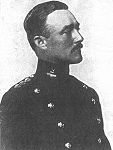 J.S.Collings-Wells V.C. D.S.O. |
 Edward Wareham-Fowler |
 Fred Lloyd |
 Leonard Robinson |
We departed from Marple at 12.45am on the morning of Thursday 25th October, a little later than anticipated because Steve had trouble removing the surplus seats from our hired seven-seater Galaxy. We managed to recover this delay and arrived in Folkstone with perfect timing to drive straight on to Le Shuttle for our scheduled 5.30am channel crossing. A further two hours driving saw us arrive at our accommodation in the tiny village of Ovillers in "Mash Valley" at only 9.00am.
It was during fierce fighting for the village of Ovillers that two of Marple's men met their untimely end. Raymond Walter and Edward Wareham-Fowler were both only 25 years old when they were killed in action on the 15th of July 1916. Raymond, a 2nd Lieutenant who enlisted in the Public Schools Battalion, was an active member of the Marple Dramatic Society. He is thought to have been killed whilst leading his men in a bayonet charge against the German trenches. Edward Wareham-Fowler was from London but worked in Hyde and lodged at Linnet Wood on St. Martins Road. He was a Lieutenant with the 7th Royal Warwickshire Regiment and was killed when the two platoons he was leading were mown down by heavy machine gun fire as they left their trench to attack the German line.
|
|
Despite tiredness and the atrociously wet weather, we decided there was no time to waste recovering from the journey and once unpacked we donned our waterproofs and ventured into the Somme. Our first visit was to the huge Thiepval Memorial, usually visible for many miles but on this day hidden in low cloud. This giant monument records the names of 73,367 men lost during the First Battle of the Somme, between 1st July and 13th November 1916. This horrendous number is just the soldiers with no known grave, not the total casualties. Seven Marple men are commemorated here, including Edward Wareham-Fowler.
On the southern side of Thiepval village was a German stronghold known as the Leipzig Salient. It was during an attack by the 11th Battalion Cheshire Regiment on this stronghold on 3rd July 1916 that 22 year old Fred Lloyd of 12 Chapel Fields suffered terrible wounds to his right leg. Although he was brought out of no mans land by his comrades Fred, who worked at the Goyt Mill as a Spinner before he enlisted, died of his wounds later that day.
We next stopped at Guillemont where the 12th Battalion Royal Scots managed to capture nearby Bernafay Wood from the Germans on 4th July 1916. They achieved this with minimal casualties but defending it after the Germans had regrouped was a different matter. The wood came under heavy bombardment from German artillery for several days and it was on the 8th of July that Arthur John Farmer of High Lane, a Sergeant with the Royal Scots was killed, almost certainly by shell fire. Arthur, who worked as a "Maker-upper" in the firewood manufacturing business, left a widow and four children. He is another of the seven commemorated on Thiepval Memorial.
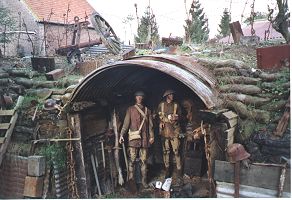 A small section of Le Tommy Bar's trench |
After a long day first day we retired to Le Tommy Bar in Pozieres for food and other essential refreshments. Le Tommy Bar is a must for anyone visiting the Somme. Run by Dominic Zinardi and his wife Melanie, it's full of photographs and memorabilia and even has a full size trench in the garden. Dominic, who used to run the Albert museum, is also a renowned expert on the First World War.
Pozieres has a magnificent white stone cemetery surrounded by high walls. These are lined on the inside by dozens of tall stone columns, rather like a Roman Coliseum. It's attractive by day but was hauntingly beautiful when lit by brilliant moonlight during our late night visit. The Australians played a huge part in the liberation of Pozieres from German forces and it's a link with that country which leads to another of our Marple men. This cemetery is the final resting place of Private Leonard Robinson, who lived on Church Street and later at Brabyns Farm. As a boy Len attended St. Martins School and Church. He went to Australia in around 1910 and when war broke out he joined the Australian army. On the morning of 31st March 1917, Len was carried into the Field Ambulance Station at Pozieres. He was suffering from a severe wound to his stomach, believed to have been caused by shrapnel from an exploding shell whilst on his way up to the trenches. Unfortunately the medical staff were unable to save him.
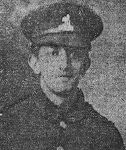 Alan Norbury |
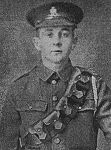 Ernest Bradbury |
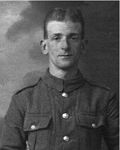 Charles Henry Ingham |
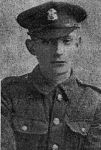 Oswald Neale |
Also commemorated in Pozieres Cemetery are three more of our Marple men. Private Alan Norbury, age 29, of The Filters in High Lane was reported missing in the Spring of 1918. It was first hoped he had been taken prisoner by the Germans but when the armistice was signed and all prisoners of war returned, Alan was not amongst them. Ernest Bradbury was a Gunner with the Royal Field Artillery and another High Lane man. He belonged to the same Liberal Club as Alan Norbury and worked at Strines Printworks. During Christmas 1917 Ernest married Miss Harriet Bennett, a Stockport girl who worked at the Goyt Mill. Only three months later Ernest was one of 445 members of the Royal Field Artillery to be killed in action during the first day of the German Spring Offensive, on 21
st March 1918. He was 24 years old. The following day saw members of the 432nd Field Company of the Royal Engineers come under enormous pressure whilst trying to hold the village of Jeancourt as the Spring Offensive continued. Sapper Charles Henry Ingham, a blacksmith by trade from Lower Farm, Marple Bridge was amongst those lost during the heavy fighting and intense artillery bombardment on the village. Charles was well know locally as a vocalist, being a member of the Marple Bridge Male Voice Choir that had won prizes at Crystal Palace in London and the Buxton Music Festival.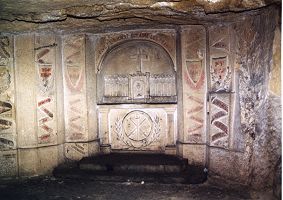 The Chapel in the caves at Berny Riviere |
On the second day of our visit we drove to a small village called Berny-Riviere to see some caves that had been used by French forces during the war. Situated on a hill in dense woodland these were very impressive with dozens of large underground chambers cut into the soft chalk. There was even a chapel dedicated to the regiments that had occupied it, with carved banners and emblems in their memory. It was whilst investigating these caves that Peter and Steve disturbed a family of wild boar and were to be seen running faster than they've done for many a year. Fortunately the boar were equally startled and ran in the opposite direction. On the memorial of the nearby town of Soisson another former worker from the Goyt Mill is commemorated. Oswald Neale of Church Street was a 29 year old Private with the 6th Battalion South Wales Borders when he was killed by an exploding shell on 28th May 1918, the second day of the Battle of the Aisne during the German Offensive in Champagne.
The third day saw us back in the Somme region near the villages of Fricourt and Mametz which were in German hands on the 1st July 1916. This was the first day of the Battle of the Somme and the blackest in British military history with 60,000 British casualties, still the greatest number ever sustained by the British Army in a single day. Two of these were Marple men and both had worked in the Goyt Mill before enlisting. Private Stanley Proctor was 22 years old and had worked there as a packer. He lived in Hawk Green and was the son of the local policemen. Another of the seven Marple men commemorated on Thiepval, Stanley served with the 15th Battalion Royal Scots and was killed during their attack on the village of La Boiselle. Private Horace Platt of the 5th Manchester Pals Battalion was only 19 years old when he too gave his life on this black day. Horace, who lived at 2 Lockside with his parents, worked in the spinning room at Hollins Mill before moving on to a new job at the Goyt. He attended the Marple Congregational Sunday School and was also associated with the Marple Recreation Club and Gymnasium before joining the army in 1914.
 Stanley Proctor |
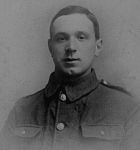 Horace Platt |
 Harry Frost |
 Thomas George Ferguson Warner M.M. |
Harry Frost, aged 27, lived at 3 Shepley Lane, Hawk Green and was yet another worker from the Goyt Mill. He was a also a Private in the 5th Manchester Pals, the same battalion as Horace Platt. During the hectic period leading up to the "Big Push" of 1st July 1916 Harry was detailed for sentry duty in a forward position in the trenches. During his watch on the 18th May 1916 he spotted a German sniper and decided to take a shot at him. Unfortunately Harry exposed too much of himself above the trench parapet whilst getting into position and was shot and killed by another German sniper who had gone unnoticed. The condolences sent to Harry's wife Annie on 24th May included a message of sympathy from fellow Goyt Mill worker Horace.
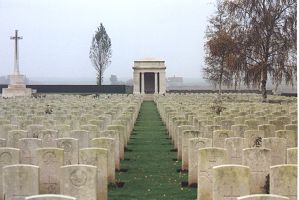 A.I.F. Burial Ground on a wet misty morning |
On our final day before departing for home we found time to visit the A.I.F. Burial Ground at Grass Lane in Flers to pay our respects to Thomas George Ferguson Warner M.M. of High Lane. Thomas was only 18 years old when he joined the 3rd Manchester Pals Battalion in September 1914. He went through severe fighting and attained the rank of Sergeant but was then wounded in June 1916. After spending time in hospitals in both France and England he returned to the front line and in January 1918 won the Military Medal for gallantry in the field and devotion to his country. Thomas finally ran out of luck on 5th April 1918 when his position came under heavy bombardment during the Spring Offensive. He was hit by a shell burst not far from where he had been wounded previously, this time he was killed immediately. Thomas was assistant Scoutmaster of the 1st High Lane Troop of B.P. Boy Scouts before he joining the army and he had become the fifth of its former members to be killed in the war.
This article hopefully gives a small insight into the background and lives of 13 local men who made the ultimate sacrifice. These particular men have been chosen because of their links to the places we visited during our trip, not because their stories are more interesting or special than the other 128 killed during the First World War, or the 50 who gave their lives during the Second. It is on this weekend especially that we should remember them all and it would have been good to tell you something of each man commemorated on the memorial. Unfortunately there is not space here but if this article has sparked an appetite for more information, copies of the book "Remembered" can still be obtained.
If you would like to get closer still, Andy Cook and Peter Clarke are organising a four day coach trip to the Somme Battlefields in April next year that will be focused on the men from Marple who fell in the Great War. Places are limited to 25, so if you are interested get in touch with Peter using our contact us page.
Don't forget to buy your poppy and if you can attend the Remembrance Day Service on Sunday in Memorial Park, it would be great to see a good turnout to remember them all this year.